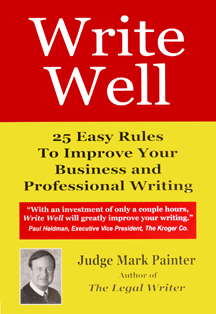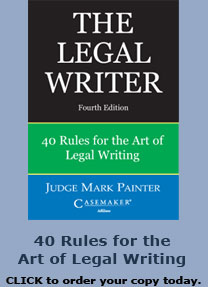The Legal Writer #19
By Judge Mark P. Painter
This month, some miscellany. Long-time readers of the column will note that the references to the “rules” refer to those in The Legal Writer 2nd Ed.: 40 Rules for the Art of Legal Writing. These were discussed in detail in previous columns. If you missed the earlier installments, there is info on how to buy the book at the end of this column.
A Rule Against Apostrophes?
Did someone ban contractions from legal writing? Is there a rule against apostrophes? Did we learn that one right after the rule against perpetuities? (An apostrophe in being, plus…) Writing is it not likely instead of isn’t it likely just sounds stuffy. If you prefer cannot for can’t, I won’t argue, but generally use the contraction if it sounds natural. And yes, sometimes the formal can supply slightly more emphasis. Write with your ear, as well as your eye and your brain.
The apostrophe is unjustly maligned. Avoiding apostrophes results in clumsy constructions. It also adds to the word count, by adding clutter. The apostrophe is a useful tool. Use it.
In addition to contractions, some writers seem to think possessives are banned. Lawyers write the docket of the court instead of the court’s docket (see Rule 23 — Always Question “Of”). Use the possessive with the apostrophe, not the longer and more pompous of construction.
Fun With Numbers
The Ohio rule is to spell out numbers one through ten. You should then use numerals for 11 and above. This is a 2002 change, and it replaced a rule that was as impossible to follow as it was to explain (something to do with spelling out numbers if you could do so with three words or fewer).
Other authorities have different rules. The Chicago Manual of Style (15th ed. 2003) favors spelling out numbers up to one hundred.
But Bryan Garner’s Dictionary of Modern American Usage (1998) specifies the one-to-ten rule, as does his Dictionary of Modern Legal Usage (2nd ed. 1995). That rule is not only better for legal writing, but mandatory in Ohio, so use it.
As with most rules, there are exceptions. If a number begins a sentence, it is spelled out, though it is often better to recast the sentence. “Nineteen ninety-nine will be remembered for…” would be much better as “We will remember 1999 for…“
Another hint: leave out the double zeros after a decimal. Write $200, not $200.00. And substitute words for rows of zeros where possible. Write $2 million, $5 billion. Write percentages with numbers and the percent (%) sign.
And remember Rule 6 — No Parenthetical Numericals. Never clutter your document with both words and numbers: “There were four (4) plaintiffs and six (6) defendants.” Never.
Too Many Dates
Lawyers and judges use too many dates (See Rule 5 — Avoid Overchronicling — Most Dates are Clutter). Using an exact date signals to the reader that it is important — that the reader should remember it for future reference. If that’s not your intention, strike it out.
You can convey continuity and order by clues like next and later. Or use “in June,” then “in July” to show chronological order.
When using month-day-year style, there is a comma before and after the year — “the ceremony of June 26, 2003, was festive.” In the day-month-year style (more prevalent in Commonwealth and European writing), there is no comma — “the ceremony of 26 June 2003 was festive.” And remember that when not using an exact date, there is no comma between the month and year: “in June 2003.”
In referring to decades, do not use an apostrophe —”during the 1980s” not “1980’s.” Actually, either is acceptable; but the modern rule, which produces cleaner looking text, is to leave out the apostrophe.
Uncommon Comma Considerations
Commas do not surround Jr., Sr., III, Inc., LLP, Ltd., and the like. Just write “John Smith Jr. is president of Minoliana Inc.” In parenthetical material, a comma never precedes a closing parenthesis, but may follow it. “When in Rome (where I went last year), be sure to see the Pantheon.” A comma is used to set off a state or country: “Chicago, Illinois, is her home.”
Cross Out Cross-References
Last month I received an email with this question: Where do you use supra and infra? My short answer — nowhere. Nor should you use op. cit. or loc. cit.
These cross-reference indicators are distracting and unnecessary in most legal writing. They abound in law reviews, so new lawyers tend to believe they are acceptable, even desirable. If you want your brief or memo to be just as unreadable — and unread — as most law reviews, then litter it with supras and infras.
When you use an infra, you are saying to the reader “I’m going to tell you about this later.” That’s just silly — if something is relevant now, talk about it now, not later.
Footnotes are for citation only (See Rule 13 — Citations go in Footnotes). So any supra or infra would automatically be in a footnote. But instead of using a supra to indicate you have cited something just a footnote or two earlier (if it is in the last footnote, it would be Id.), it’s more convenient for the reader if you just repeat the cite.
Next month: Another victory!
Column stats: Words per sentence — 13.2 (See Rules 16 — Write Short Sentences); passive sentences — 7 percent (See Rule 17 — Use Mainly Active Voice); grade level — 8.2.
____________________________________
Mark Painter is a judge on the Ohio First District Court of Appeals and an Adjunct Professor at the University of Cincinnati College of Law. He is the author of five books, including The Legal Writer 2nd ed.: 40 Rules for the Art of Legal Writing. The book is available at Joseph-Beth Booksellers in Cincinnati and Cleveland, The Book Loft in Columbus, the Ohio Book Store in Cincinnati, Barnes & Noble in Cincinnati (Kenwood), and from Ohio Lawyers Weekly Books at http://books.lawyersweekly.com. Judge Painter has given dozens of seminars on legal writing. Contact him at jugpainter@aol.com, or through his website at www.judgepainter.org.








